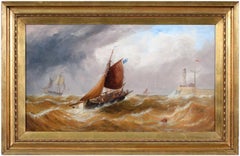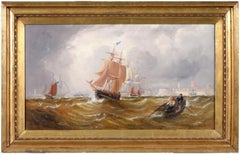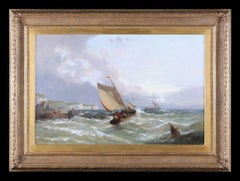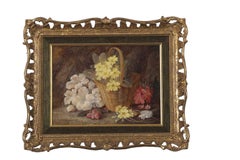John Callow Art
to
2
1
Overall Width
to
Overall Height
to
3
2
3
3
2
2
3
3
3
10,042
2,764
1,381
1,375
3
3
Artist: John Callow
South Pier, Sunderland 19th century oil , john callow
By John Callow
Located in York, GB
A fine 19th century oil on canvas painting "South Pier, Sunderland "
signed and indistinctly dated 1844, the size of the painting being approx. 45 x 80 cm whilst overall size bei...
Category
1840s Old Masters John Callow Art
Materials
Oil
Off Portsmouth Harbour 19th century oil , john callow
By John Callow
Located in York, GB
Off Portsmouth Harbour 19th century oil , john callow
A fine 19th century oil on canvas painting "off Portsmouth harbour "
signed and indistinctly dated 1844, the size of the paint...
Category
1840s Old Masters John Callow Art
Materials
Oil
Stormy Seas
By John Callow
Located in St. Albans, GB
John CALLOW
Picture Size: 26 x 40" (66 x 102cm)
Outside Frame Size: 38 x 52" (97 x 132cm)
It framed in the original frame chosen by the artist gilded in gold leaf.
Free Shipping
...
Category
1860s Victorian John Callow Art
Materials
Oil
Related Items
Vintage painting by Vincent Clare - dead nature art composition- oil on canvas.
By Vincent Clare
Located in PARIS, FR
Conditions: Very good overall condition. Edge right, visible under UV Light, minor retouching (5mm). The frame is period frame original baring stickers from Galleries in London. Low...
Category
Late 19th Century Victorian John Callow Art
Materials
Oil
$2,151
H 8.66 in W 11.81 in
'Cavalier's Pets' 19th century Oil Painting
By Sir Edwin Henry Landseer, 1802-1873
Located in Hillsborough, NC
'The Cavalier's Pets' by Sir Edwin Henry Landseer was exhibited in 1845, and is now in the collection of the Tate Museum of Art in London. This is a fine oil painting copy of the famous Landseer painting. This is a well executed work with all the hallmarks of a Victorian 19th century painting...
Category
Late 19th Century Victorian John Callow Art
Materials
Canvas, Oil
$1,832 Sale Price
34% Off
H 16 in W 24 in D 1 in
Country Cottage
By Abraham Hulk the Younger
Located in Hillsborough, NC
Late 19th/early 20th century oil on canvas painting in the manner of Abraham Hulk the Younger (1851-1922), and George Vincent (1796-1832). These artists painted in the Dutch style, though both are British. Each has had experience with Dutch masters that influence their work. George Vincent’s work is perhaps even closer to this than Hulk’s. Vincent paints the trees and skies with the warm hues of light infused on the work. Here, the sky has blue but also a khaki or tan shade, roughed into the blue and white. It is an unusual color in skies, yet Vincent shows us the light through clouds castingva darker shade. The trees are varied greens but also yellowed leaves, as in autumn.
Presented in a period decorative gilt frame, the painting is of a cottage in a woodland with cattle by a pond, a little black dog and man and a woman standing by. In the distance is a glimpse of a river and grasses, framed by trees and an overcast sky.
Hulk is renowned for his treatment of the changing season from summer to autumn, and the golden leaves and fading greens in this painting suggest this changing time of year.
Hulk is the son of a well known Dutch maritime...
Category
Late 19th Century Victorian John Callow Art
Materials
Canvas, Oil
Arabian Rider at Dusk
By Adolf Schreyer
Located in Austin, TX
Adolf Schreyer's "Arabian Rider at Dusk" is a stunning oil painting on canvas that depicts an Arabian rider in a golden sunset.
By Adolf Schreyer
8.5" x 15.5" Oil on Canvas
Framed...
Category
19th Century Victorian John Callow Art
Materials
Canvas, Oil
Allegory of Abundance
Located in New York, NY
Painted in collaboration with Hendrick van Balen (Antwerp, 1575 – 1632).
Provenance: Private Collection, Uruguay, since the 1930s.
The eldest son of Jan Br...
Category
17th Century Old Masters John Callow Art
Materials
Copper
Announcement in Village Square mid 19th century
Located in Hillsborough, NC
Fine 19th century oil painting of a bustling Austrian/Germanic village with horse, rider and various figures outside an Inn, attributed to Arthur Georg Ramberg (1819-1879), well known for figurative genre paintings. The rider is carrying a bugle, apparently announcing news to the people; men are sitting by the table drinking, one with a raised stein. Women walking by stop to listen, a man carrying a sack has stopped to watch the rider, people are in the Inn doorway, and one is looking out the window. Children pause their playing. The scene is under a large tree beside the Inn; a whole community waiting for news.
There is a great deal of detail in the scene, tree and Inn house...
Category
19th Century Victorian John Callow Art
Materials
Canvas, Oil
$1,300 Sale Price
50% Off
H 20 in W 22 in D 2 in
Landscape Near Felday, Surrey
By Abraham Hulk the Younger
Located in Hillsborough, NC
Dutch/English artist Abraham Hulk the Younger (1851-1922) is most known for landscapes of the British countryside. This work is one of a pair (the second work is also available by s...
Category
Late 19th Century Old Masters John Callow Art
Materials
Canvas, Oil
$1,960 Sale Price
30% Off
H 27 in W 22.75 in D 2.13 in
17th Century by Felice Torelli Hagar and the Angel Oil on Canvas
Located in Milano, Lombardia
Felice Torelli (Verona, Italy, 1667 - Bologna, Italy, 1748)
Title: Hagar and the Angel
Medium: Oil on canvas
Dimensions: without frame 41 x 116 cm - wit...
Category
Late 17th Century Old Masters John Callow Art
Materials
Cotton Canvas, Canvas, Oil
$18,167 Sale Price
20% Off
H 20.67 in W 50.01 in D 1.97 in
The Little Flower Seller, British Les Miserables image, Victorian oil painting
Located in Hillsborough, NC
Mesmerizing image, ‘The Little Flower Seller’ is reminiscent of Cosette in Les Miserable, her hair blown to one side and her red ribbon flowing out from her hair. She is that unloved...
Category
Late 19th Century Victorian John Callow Art
Materials
Oil, Board
$2,800 Sale Price
30% Off
H 14.5 in W 11.5 in D 1 in
Exhibited RSA 1862 Portrait of Girl with Dogs Blossom and Bob
By Gourlay Steell
Located in Hillsborough, NC
Portrait of Girl and Dogs is signed and dated 1861 and exhibited in 1862 is by Gourlay Steell, (1819-1894) RSA, appointed as Animal Painter for Scotland to Queen Victoria’s Court aft...
Category
1860s Victorian John Callow Art
Materials
Canvas, Oil
$10,000 Sale Price
20% Off
H 25.5 in W 31 in D 3 in
19th Century landscape oil painting of sheep grazing on a clifftop
By Charles Jones (b.1836)
Located in Nr Broadway, Worcestershire
Charles Jones
British, (1836-1892)
Sheep Grazing on a Cliff Top
Oil on canvas, signed with monogram
Image size: 7.5 inches x 11.5 inches
Size including frame: 13.5 inches x 17.5 inches
A lovely landscape painting of sheep on a coastal cliff by Charles ‘Sheep’ Jones. The sheep and her two lambs are depicted against the backdrop of the sea with shipping and chalk cliffs in the distance. The location is likely to be the Devon coast, an area Jones visited often.
Charles Jones was an animal painter who was born in Stepney, London in 1836. He was the son of the artist Samuel John Egbert Jones (1797-1861) and Dinah Jones. He lived with his parents and 9 siblings in Mile End and was a pupil of his father. In September 1859, he married Frances Rosalinda Downe, who was born in America. His son Arthur Bertram Loud (1863-1930) also became an artist. They lived at 12 Hayes Place, Lisson Grove from where he made his debut in London at the Royal Academy in 1861. He also exhibited at the British Institution, Suffolk Street, New Watercolour Society, Royal Institute of Oil Painters and the Royal Institute of Painters in Watercolours.
By 1867, he had become a successful artist and had moved to 7 Paragon Place, Brixton Hill. From 1874, he lived at Heathercroft, Balham Hill where he spent the rest of his life. As well as the major London galleries, he also exhibited provincially at various locations including: the Royal Cambrian Academy where he was elected a member in 1886, the Glasgow Institute of Fine Arts, Manchester City Art Gallery, Royal Hibernian Academy, Royal Society of British Artists, Birmingham and the Walker Art Gallery, Liverpool. Some of the smaller more intimate galleries he exhibited at were Arthur Tooth & Sons and Thomas Richardson...
Category
19th Century Victorian John Callow Art
Materials
Canvas, Oil
$4,705
H 13.5 in W 17.5 in D 2 in
17th Century by Felice Torelli Rachel Hiding the Idols Oil on Canvas
Located in Milano, Lombardia
Felice Torelli (Verona, Italy, 1667 - Bologna, Italy, 1748)
Title: Rachel Hiding the Idols
Medium: Oil on canvas
Dimensions: without frame 41 x 116 cm -...
Category
Late 17th Century Old Masters John Callow Art
Materials
Canvas, Cotton Canvas, Oil
$15,537 Sale Price
20% Off
H 20.67 in W 50.01 in D 1.97 in
Previously Available Items
Oil Painting attributed John Callow "A Blustery day off the Coast"
By John Callow
Located in Mere, GB
Oil Painting attributed John Callow "A Blustery day off the Coast" Oil on canvas signed with initials.
Dimensions unframed 8 x 12 inches
Dimensions framed 10.5 x 14 inches
All of t...
Category
19th Century John Callow Art
Materials
Oil
H 10.5 in W 14 in D 2 in
John Callow art for sale on 1stDibs.
Find a wide variety of authentic John Callow art available for sale on 1stDibs. You can also browse by medium to find art by John Callow in oil paint, paint and more. Not every interior allows for large John Callow art, so small editions measuring 14 inches across are available. Customers who are interested in this artist might also find the work of Adolphus Knell, George Armfield, and William Shayer Senior. John Callow art prices can differ depending upon medium, time period and other attributes. On 1stDibs, the price for these items starts at $1,650 and tops out at $10,775, while the average work can sell for $6,212.




